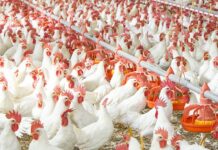UNITED NATIONS: World food prices rose for a fourth straight month in November to remain at 10-year highs, led by strong demand for wheat and dairy products, according to Food and Agriculture Organization (FAO), a Rome-based UN agency.
The FAO’s Food Price Index, which measures the monthly change in the international price of cereal, dairy, meat, vegetable oils and sugar, jumped 1.6 points in November from the previous month to 134.4. That is the highest level in a decade and the fourth consecutive month the index has risen.
Prices of cereals and dairy saw the sharpest gains, followed by sugar, while prices of meat and vegetable oils fell slightly in November from the previous month.
Inflation for essentials including food and energy has skyrocketed this year, thanks to supply-chain snarls and shortages as countries cast off COVID-19 restrictions.
Soaring food prices are hitting low-income households especially hard because higher prices for essentials like bread, meat, milk and rice eat up a larger share of their incomes.
The pain inflicted on consumers has placed central banks the world over in a tough position because higher interest rates help cool inflation, but they also risk denting fragile economic recoveries.
The FAO Dairy Price Index led November’s aggregate rise, increasing by 3.4 percent from the previous month. Strong global import demand persisted for butter and milk powders as buyers sought to secure spot supplies in anticipating of tightening markets.
The FAO Cereal Price Index increased by 3.1 percent in November from the previous month and was 23.2 percent higher than its year-ago level. Maize export prices rose slightly and international rice prices remained broadly steady, while wheat prices hit their highest level since May 2011.
The increase reflected strong demand amid tight supplies, especially of higher quality wheat, while prices were also supported by concerns about untimely rains in Australia and uncertainty regarding potential changes to export measures in the Russian Federation.
The FAO Sugar Price Index was 1.4 percent higher in November than in October and nearly 40 percent above its level in November 2020. The increase was primarily driven by higher ethanol prices, though large shipments from India and a positive outlook for sugar exports by Thailand tempered the upward pressure on quotations.
The FAO Vegetable Oil Price Index declined by 0.3 percent from a record high reached in October, reflecting lower values for soy and rapeseed oils as well as lower crude oil prices. International palm oil prices remained firm.
The FAO Meat Price Index decreased by 0.9 percent, its fourth consecutive monthly decline. Influenced by reduced purchases of pig meat by China led to lower international quotations, while ovine prices also fell steeply on increased exportable supplies from Australia. Bovine and poultry meat prices were largely stable.
FAO’s new Cereal Supply and Demand Brief, also published Thursday, forecasts world cereal production at 2 791 million tonnes in 2021, a new record and 0.7 percent higher than the previous year. Compared to 2020, worldwide coarse grains and rice outputs are expected to increase, respectively, by 1.4 percent and 0.9 percent, while that for wheat to drop by 1.0 percent.
World cereal utilization in 2021/22 is forecast to rise by 1.7 percent to 2 810 million tonnes, while world cereal stocks by the close of seasons in 2022 are predicted to decline by 0.9 percent form opening levels. The consequent stocks-to-use ratio of 28.6 percent “would still indicate a comfortable supply situation overall,” according to FAO.
FAO forecasts global trade in cereals in 2021/22 to increase by 0.7 percent to 480 million tonnes, with an anticipated 2.2-percent expansion in world wheat trade more than offsetting a likely contraction in coarse grains trade.
Conflicts and drought are exacerbating food insecurity conditions in several parts of the world, particularly in East and West Africa, according to the latest Crop Prospects and Food Situation Report, also released today. FAO assesses that globally 44 countries, including 33 in Africa, nine in Asia and two in Latin America and the Caribbean, are in need of external assistance for food.
The 44 countries in need of external assistance for food are: Pakistan, Afghanistan, Bangladesh, Burkina Faso, Burundi, Cameroon, Central African Republic, Chad, Congo, Democratic People’s Republic of Korea, Democratic Republic of Congo, Djibouti, Eritrea, Eswatini, Ethiopia, Guinea, Haiti, Iraq, Kenya, Lebanon, Lesotho, Liberia, Libya, Madagascar, Malawi, Mali, Mauritania, Mozambique, Myanmar, Namibia, Niger, Nigeria, Senegal, Sierra Leone, Somalia, South Sudan, Sudan, Syrian Arab Republic, Uganda, United Republic of Tanzania, Venezuela, Yemen, Zambia and Zimbabwe.
The quarterly report also provides updates on cereal harvest trends, forecasting production in 2022 to grow by 2.0 percent in developed countries but slightly contracting by 0.1 percent in developing countries. For Low-Income Food Deficit Countries, the contraction is expected to be 2.4 percent, due to significant drops foreseen in Near East and East Africa.






















